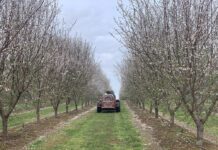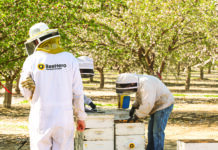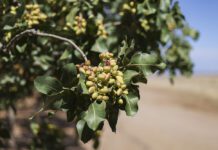Hmmm… time to assess the hand that Mother Nature has dealt as the orchards leaf out and the growing season begins. This isn’t draw poker; all cards are final.
Another wet winter is slowly ending. The rainfall amounts are good news but tree nut prices are below the cost of maintaining healthy, productive orchards and delivering high-quality crops. Still, a wet winter means a root zone full of sweet (not salty) moisture good early season reservoir levels. This means there is good potential for healthy orchards this season.
To balance that good news, there could be good chances of a large crop statewide, at least based on the season so far. Bloom weather was generally mild with some rain but much better bee hours than last year. With the number of acres in the ground, just an average crop per acre up and down the state should mean a statewide crop in the 3-billion-pound range (±0.1 billion pounds.)
So, with light prices relative to costs and good chances for an average-plus crop, what’s the plan to get through this season and next with the best results? Experienced growers I’ve talked to or heard speak generally agree that the trick to staying in the game long-term will be shaving costs without eliminating any basic proven practice: small ball, not homers. In a low-price market, dropping one or more proven practices risks further income loss through reduced yield, quality or both. Producing a good crop (yield and quality) will help if you are digging into equity to grow this crop. The shallower the hole dug now, the faster you should get out of it as things get better (hopefully they do before too long.)
Almond
Water
The wet winter and surface water situation for 2024 is a big plus. As I write this, the federal water project allocation is at 75%, and the March forecast from the National Weather Service is for elevated chances of rain in the Sacramento and northern San Joaquin Valleys. Fingers crossed for a full allocation this year.
Improving your game in irrigation is a solid goal. Start out the season with good irrigation distribution. Mobile labs can help take the measures. Good irrigation is the most important factor in successful tree crop production. Period. There is no more important activity in an arid land. The best tree health, crop yield and pest management are delivered under good irrigation practices. The best tool for determining irrigation status is the pressure chamber. If you are new to this topic or want a source of information for review, check out the excellent nine-article series on stem water potential listed in the reference articles at the end of the column.
If you are not using a pressure chamber, soil moisture and/or evapotranspiration (ET) estimates plus soil water holding capacity can be used to gauge soil dry-down to the point where an irrigation set refills but not overfills the soil profile, harming root health. See the Almond Board’s Irrigation Continuum in the references. Irrigation is important, and using several monitoring tools helps get it right.
The goal of April irrigation is to shift smoothly from rainfed to hose-fed soil moisture without stressing the tree with too much water (bad for root health) or too little (limits shoot/spur that limits future flower sites).
Pests
The 2023 navel orangeworm (NOW) damage levels were rough. While it’s too early to know how the 2024 NOW season will turn out, some early points are worth noting. There is a general sense that while sanitation was better this past winter than the previous winter, there are mummies in many orchards, and given the damage last year, there should be more NOW in the surviving mummies than last year. This means more NOW overall pressure as the season starts.
Comparing spring NOW egg numbers to past years will help bring the pressure situation into focus. Biofix (first eggs of the season) should be around mid-April at the earliest this year in the Sacramento Valley. The trap count history over the last 10 years at the Nickels Soil Lab in Arbuckle suggests NOW biofix in those orchards will be somewhere around April 13 to 19. A later biofix often means, but doesn’t guarantee, that more of the second generation of NOW eggs goes on the new season nuts than the mummies. That can mean building pressure as Nonpareil harvest approaches in August. We’ll know more as the season progresses.
What are effective NOW management practices in the spring? Mating disruption (NOW MD) reduced net economic loss when processor reject numbers were 1% or higher in UC trials in two years. The work was done in 2017-18 when tree nut prices were higher, so the breakeven point might need to be adjusted slightly higher, but if you had industry-average damage of 4% to 5% reject losses in 2023, MD would have more than paid for itself based on the UC research results. All commercial, season-long products were equally effective in UC trials when used following manufacturers’ guidelines. The larger the acreage that uses NOW MD, the better the effect on the moths and the reduction of damage. Almond Board of California has put together an interactive map where growers can share location of orchards with mating disruption (and walnuts and pistachios) and, perhaps, build a larger area where the NOW population may be reduced. See the site at agneighbors.com.
The “mummy sprays” targeting early egg laying on mummies can have value, especially if there are lots of mummies in the orchard. However, an early spray for NOW should be an additional spray, not one used in place of a hullsplit spray. The current recommendation from UC researchers and advisors is two sprays of effective, long-lasting materials (Altacor, Intrepid, Intrepid Edge, etc.) in June/July targeting the second generation of NOW followed by timely harvest. A mummy spray should be in addition to the two hullsplit sprays, and that gets expensive.
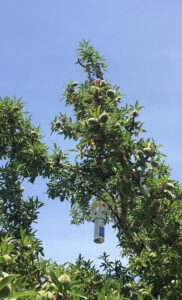
Where will the money come from to pay for the increase in NOW control practices most probably needed to get through 2024 with a reasonably clean crop? One place could be biological spider mite management. With good irrigation and careful monitoring for spider mites and their predators, especially sixspotted thrips, miticides may not be needed this year. See monitoring details at the end of the column, especially the YouTube video with David Haviland.
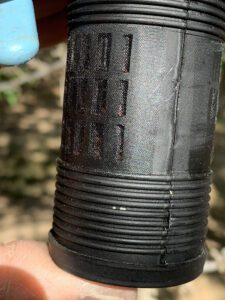
True bugs (stinkbugs and leaffooted bugs) are a growing problem in many regions of the state. Brown-spot on harvested almonds is believed to be from stinkbug, especially green stinkbug, which overwinter in almond orchards. Look for barrel-shaped eggs in masses, often on almond hulls. More information on stink bugs is available from UC IPM.
Get ahead of ant damage this spring before the rush of harvest. Scout for protein-feeding ants beginning in April to June. Talk with your PCA regarding control options if scouting shows a need.
Disease
Talk with your PCA/CCA about disease risk and control options based on current orchard conditions and forecast weather. Disease pressure builds in an orchard, especially spring and summer diseases, so knowing when conditions are risky is key to best disease control. Almond Board of California, working with UC researchers and Semios, has sponsored a disease prediction webpage that forecasts relative risk of anthracnose, alternaria, bacterial spot and bacterial blast in general regions of the state. See the page at ag-radar.com/almond. The password is Almondboard2022.
Almond rust is a foliar disease not covered in the disease prediction webpage. Weekly monitoring helps ID early symptoms and apply control sprays before the infections spread and defoliation occurs at harvest.
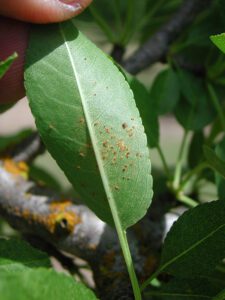
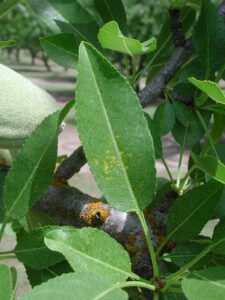
Where water stood for days after heavy rains on susceptible rootstocks (see new UC info on almond rootstocks) this past winter and/or spring, PRCR (phytophthora root and crown rot) maybe an issue. Talk with your PCA about new and established fungicide options for phytophthora control. Growers now have multiple effective options. See page 37 of the 2022 Fungicide Efficacy and Timing publication for efficacy of registered products.
After the wet winter last year, aerial phytophthora infections were common up and down the Central Valley. Phosphite materials are the most effective material against aerial phytophthora and should go on as a foliar spray soon as enough leaf area has developed. Blocks with vulnerable rootstocks (especially peach and peach x almond hybrid) and saturated soils in the spring are most at-risk.
Nutrition
If it’s a big crop this year, nitrogen and potassium demand will be up, and meeting that demand could cost hundreds of dollars per acre. Early season leaf sampling/analysis results can help learn if crop nutrient demand is high or low, so be as efficient as possible with fertilizer inputs. Relatively low levels of leaf N early in the season can indicate a large crop and the need for more N fertilizer.
The early leaf sampling window in almond is 45 days (±6 days) after full bloom using the UC Davis April sampling protocol. See details of the sampling and analysis (and more crucial N management info) in the free Best Management Practices for Nitrogen booklet from Almond Board of California. See page 14 for details on the early season sampling protocol. Private labs have developed their own guidelines for interpreting early season leaf sample results. Talk with your CCA about what is available.
Walnut
Walnut bloom may just be getting started as April begins and this issue hits your mailbox and or inbox.
Water
Recent research suggests first irrigation in walnut can be delayed for weeks beyond the traditional start time with little impact on trees, and with water and money savings to the grower. This should be done with the help of pressure chamber readings to track orchard water status and using an irrigation threshold of -2 to -3 bars below (more negative) than baseline. This same irrigation threshold can be used all season and help reduce irrigation costs.
Pests
Walnut blight is a major pest of walnut, and the traditional approach to managing blight is a combination of two of copper, EBDC fungicide (Dithane, Manzate, etc.) or the new bactericide Kasumin® for both highly effective disease control and resistance management. Using just copper risks resistance buildup. Mixing copper and Dithane or Manzate provides excellent blight and anthracnose control along with decent levels of Botryosphaeria (Bot) control. Copper alone provides slightly less blight efficacy (4/5 not 5/5 in the UC guide) and no anthracnose or Bot control.
Phytophthora damages walnut, too. If all or part of the orchard has been flooded this winter or spring, talk with your PCA about control options.
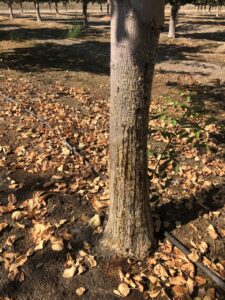
Nutrition
Nitrogen demand per acre in walnut is less than almond, and that demand starts later in the spring. With a crop removal of approximately 30 to 35 lb. N/ton inshell walnuts plus 5 to 8 lb. N to support new shoot growth, about 120 lb. N/acre is used by a 3-ton/acre crop. Adjusted for 75% nutrient use efficiency (N in the tree/N applied) means 160 lb.
N/acre/year should be applied to deliver 120 lb. N/acre to the trees. How much fertilizer does that come out to? For UN-32, 160 lb. N works out to 500 lb. (141 gal). Walnut tree N use is constant through the summer, so the recommendation is to apply 25% of the annual budget each month from May through August. In the case of the example from above, this works out to 40 lb. N (11.3 gallons UN-32)/acre/month from May through August.
Potassium is important for productive walnut orchards, and K should be added to keep July leaf K levels at 1.5% K or above. Potassium demand in walnut is generally less than in almond, partially because hull pieces drop through the walnut pickup chain and return K to the soil as they degrade.
Best wishes for a good nut set for all growers and a rise in price for walnut and almonds.
Resources
Climate forecast: cpc.ncep.noaa.gov/
Irrigation
Mobile irrigation labs:
tehamacountyrcd.org/mobile-irrigation-lab
sutterrcd.specialdistrict.org/mobile-irrigation-lab-367e01c
yolorcd.org/what-we-do/bilingual-mobile-irrigation-lab/
https://www.northwestkernrcd.org/
Irrigating almonds
almonds.com/sites/default/files/2020-02/Almond-Irrigation-Improvement-Continuum.pdf
https://www.sacvalleyorchards.com/manuals/stem-water-potential/
Irrigating walnuts
Pulling the trigger for the start of irrigation in the spring: Too much too soon for walnuts?
Pests
ipm.ucanr.edu/agriculture/almond/navel-orangeworm/
ipm.ucanr.edu/agriculture/almond/webspinning-spider-mites/
ipm.ucanr.edu/agriculture/almond/stink-bugs/
ipm.ucanr.edu/agriculture/almond/ants/
ipm.ucanr.edu/agriculture/almond/ants/
youtube.com/watch?v=ufJ4VCa-IFI (a great video on spider mite monitoring with David Haviland, UCCE Entomology Advisor in Kern Co)
https://ipm.ucanr.edu/agriculture/ (At the bottom of this page is a link to the free, 73-page document from UC IPM “Fungicides, bactericides, biocontrols, and natural products for deciduous tree fruit and nut, citrus, strawberry and vine crops in California, 2022.)
sacvalleyorchards.com/almonds/trunk-soil-diseases/aerial-phytophthora-outbreaks-in-wet-years/ Recent article on aerial phytophthora from UC experts. Lots of great pictures.
Nutrition
almonds.com/almond-industry/orchard-management/soil-quality-and-nutrients/nutrient-management
Rootstocks
fruitsandnuts.ucdavis.edu/almond-rootstock-comparison-chart



